
Phyllomedusa burmeisteri, also known as Burmeister's leaf frog and common walking leaf frog, is a species of frog native to the Atlantic Forest biome in Brazil.

Phyllomedusa bicolor, the giant leaf frog, bicolor tree-frog, giant monkey frog, or waxy-monkey treefrog, is a species of leaf frog. It can be found in the Amazon basin of Brazil, Colombia (Amazonas), Bolivia, and Peru, and can also be found in the Guianan Region of Venezuela and the Guianas, and in Cerrado of the state of Maranhão in Brazil.

Agalychnis psilopygion is a species of frog in the subfamily Phyllomedusinae. It is found in southern Colombia and north-western Ecuador. It has been observed between 100 and 500 meters above sea level.
Phrynomedusa appendiculata, the Santa Catarina leaf frog, is a species of frog in the subfamily Phyllomedusinae. It is endemic to Brazil, where it is only known from the southern Atlantic Forest.
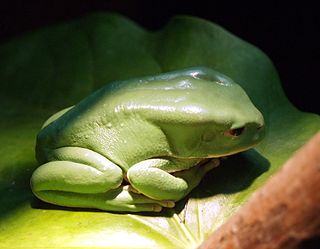
Phyllomedusa boliviana is a species of frog in the subfamily Phyllomedusinae. It is found in Argentina, Bolivia, and Brazil. It has been observed between 200 and 1800 meters above sea level.

Phyllomedusa camba or the black-eyed monkey frog is a species of frog in the subfamily Phyllomedusinae. It is found in Bolivia, Brazil, and Peru. It has been observed between 280 and 1000 meters above sea level.
Pithecopus centralis is a species of frog in the subfamily Phyllomedusinae. It is endemic to Brazil, where it has been observed solely above 520 meters above sea level. People have seen it higher than 520 meters above sea level.
Phyllomedusa coelestis is a species of frog in the subfamily Phyllomedusinae. It is found in Colombia, Ecuador, and Peru between 200 and 1000 meters above sea level.

Phyllomedusa distincta is a species of frog in the subfamily Phyllomedusinae, endemic to Brazil. It has been observed as high as 1000 meters above sea level.
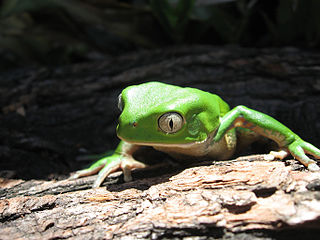
Phyllomedusa iheringii is a species of frog in the subfamily Phyllomedusinae. It is found in southernmost Brazil and Uruguay. The specific name iheringii honors Hermann von Ihering, a German-Brazilian zoologist. However, common name southern walking leaf frog has been proposed for it.
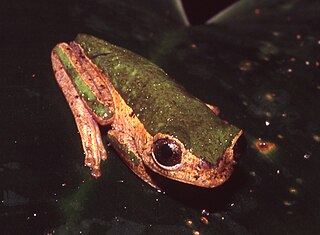
Pithecopus palliatus is a species of frog in the subfamily Phyllomedusinae. It is found in Bolivia, Brazil, Ecuador, Peru, and possibly Colombia. Its natural habitats are subtropical or tropical moist lowland forests and intermittent freshwater marshes. It is threatened by habitat loss. It has been observed between 100 and 400 meters above sea level.
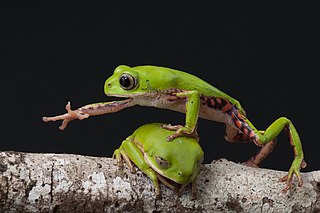
Pithecopus rohdei, also known as Rohde's leaf frog, Rohde's frog, and Mertens' leaf frog, is a species of frog in the subfamily Phyllomedusinae. The species was previously placed in the genus Phyllomedusa. The species is endemic to southeastern Brazil and occurs at elevations up to 1000 meters above sea level.

Phyllomedusa tarsius, the brownbelly leaf frog or tarsier leaf frog, is a species of frog in the subfamily Phyllomedusinae. It is found in Brazil, Colombia, Ecuador, Peru, and Venezuela, and possibly Bolivia and Guyana. This frog has been observed as high as 800 meters above sea level.

Phyllomedusa tetraploidea is a species of frog in the subfamily Phyllomedusinae. It is found in northern Argentina, extreme southeastern Paraguay, and southern Brazil. It occurs in rainforest on herbaceous vegetation near swamps at elevations of 400–1,000 m (1,300–3,300 ft) above sea level. It also occurs in secondary forest and pastures. The eggs are deposited in leaf nests above the water in permanent forest pools; the tadpoles develop in the pools. It is a common species in Brazil and Argentina. Habitat loss caused by agricultural activities is a threat to it. It is present in several protected areas.

Callimedusa tomopterna, the tiger-striped tree frog, is a species of frog in the subfamily Phyllomedusinae. It is found in northern South America in the Upper Amazon Basin of Bolivia, Peru, Ecuador, and Colombia, Amazonian Brazil, and the Guianas from southeastern Venezuela to French Guiana. It might represent more than one species.
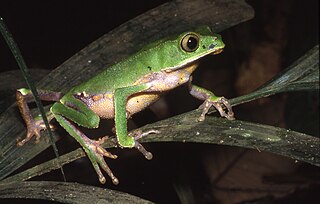
The white-lined leaf frog is a species of frog in the subfamily Phyllomedusinae. It is found in northern South America. Its natural habitats are subtropical or tropical moist lowland forest, subtropical or tropical swampland, rivers, and freshwater marshes. It is threatened by habitat loss.
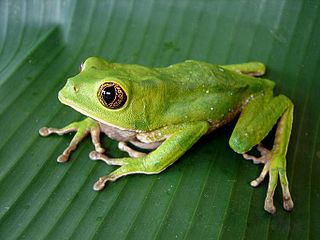
Phyllomedusa venusta is a species of frog in the subfamily Phyllomedusinae, found in Colombia and Panama. Scientists have seen it between 800 and 1400 meters above sea level.

Pithecopus rusticus is a species of frog in the family Hylidae, endemic to Brazil. This frog has been observed 1330 meters above sea level.
Phyllomedusa neildi is a species of frog in the family Hylidae endemic to Venezuela. Scientists know this frog solely from its type locality: Sierra de San Luís. This frog has been observed between 550 and 1150 meters above sea level.
Phyllomedusa chaparroi is a species of treefrog in the subfamily Phyllomedusinae endemic to Peru. Scientists have only seen it in two places. This frog has been observed between 537 and 650 meters above sea level.
















